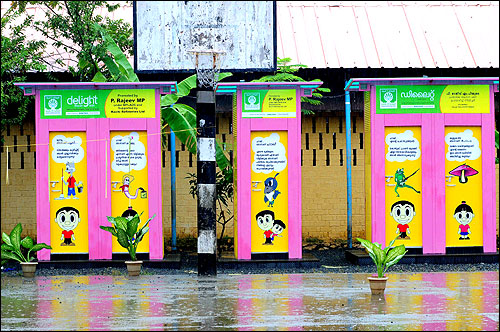How many Indian homes had access to toilets?
October 02, 2024 09:49
Shikha Chaturvedi/Business Standard
The Swachh Bharat Mission (SBM), launched on Mahatma Gandhis birthday 10 years ago, has given an opportunity to reflect on its achievements and challenges.
The initiative comprises two components: Gramin (rural) and Urban, aimed at eliminating open defecation, improving unsanitary toilets, eradicating manual scavenging, enhancing solid waste management, and promoting behavioral change regarding sanitation.
For 2023-2024, Rs 7,192 crore (Rs 71.92 billion) was allocated for the rural sector, while Rs 5,000 crore (Rs 50 billion) was earmarked for urban areas.
Allocation to the rural part of the mission saw a rebound in 2022-2023 after a decline for four consecutive years, while for the urban segment there was a marked increase in only 2023-2024 (Revised Estimates).
The Budget allocation for this year is projected to see a minuscule increase in the rural component. However, allocation to urban parts saw a massive downward revision in Revised Estimates of 2023-2024 from the Budget Estimates by around 49 per cent.
Open defecation was the central focus of the initiative, and the government declared India 'Open Defecation Free' (ODF) in 2019. Although there has been a decrease in open defecation, the data from the World Bank shows that 11 per cent of the population still practised it in 2022, mostly in rural areas.
This remains higher than in neighbouring countries like Pakistan (6.8 per cent) and Afghanistan (8.8 per cent). The government now aims to make villages ODF Plus. Currently, 93 per cent of villages have achieved this status, according to the official data.
Additionally, 78 per cent of the waste is processed. The government has exceeded its toilet construction target of 507,587 by 25 per cent, completing 636,826 toilets.
Moreover, access to toilet facilities has improved significantly, with 82.5 per cent of households reporting access in 2019-21, up from 45 per cent in 2004-2005. Urban centres have 95.6 per cent access to toilets compared to 76 per cent in rural India.
Experts note that improvements in sanitation facilities have led to a threshold effect, where district-level toilet coverage of 30 per cent or more correlates with significant reductions in infant and child mortality rates.
Studies reveal that districts with over 30 per cent toilet coverage under SBM experienced reductions of 5.3 in the Infant Mortality Rate and 6.8 in the Under-5 Mortality Rate per thousand live births.
Data from the World Bank indicates a decline in these rates, but the reductions have not been as dramatic post-implementation of the Swachh Bharat Abhiyan.
The Swachh Bharat Mission (SBM), launched on Mahatma Gandhis birthday 10 years ago, has given an opportunity to reflect on its achievements and challenges.
The initiative comprises two components: Gramin (rural) and Urban, aimed at eliminating open defecation, improving unsanitary toilets, eradicating manual scavenging, enhancing solid waste management, and promoting behavioral change regarding sanitation.
For 2023-2024, Rs 7,192 crore (Rs 71.92 billion) was allocated for the rural sector, while Rs 5,000 crore (Rs 50 billion) was earmarked for urban areas.
Allocation to the rural part of the mission saw a rebound in 2022-2023 after a decline for four consecutive years, while for the urban segment there was a marked increase in only 2023-2024 (Revised Estimates).
The Budget allocation for this year is projected to see a minuscule increase in the rural component. However, allocation to urban parts saw a massive downward revision in Revised Estimates of 2023-2024 from the Budget Estimates by around 49 per cent.
Open defecation was the central focus of the initiative, and the government declared India 'Open Defecation Free' (ODF) in 2019. Although there has been a decrease in open defecation, the data from the World Bank shows that 11 per cent of the population still practised it in 2022, mostly in rural areas.
This remains higher than in neighbouring countries like Pakistan (6.8 per cent) and Afghanistan (8.8 per cent). The government now aims to make villages ODF Plus. Currently, 93 per cent of villages have achieved this status, according to the official data.
Additionally, 78 per cent of the waste is processed. The government has exceeded its toilet construction target of 507,587 by 25 per cent, completing 636,826 toilets.
Moreover, access to toilet facilities has improved significantly, with 82.5 per cent of households reporting access in 2019-21, up from 45 per cent in 2004-2005. Urban centres have 95.6 per cent access to toilets compared to 76 per cent in rural India.
Experts note that improvements in sanitation facilities have led to a threshold effect, where district-level toilet coverage of 30 per cent or more correlates with significant reductions in infant and child mortality rates.
Studies reveal that districts with over 30 per cent toilet coverage under SBM experienced reductions of 5.3 in the Infant Mortality Rate and 6.8 in the Under-5 Mortality Rate per thousand live births.
Data from the World Bank indicates a decline in these rates, but the reductions have not been as dramatic post-implementation of the Swachh Bharat Abhiyan.





 © 2024 Rediff.com -
© 2024 Rediff.com -